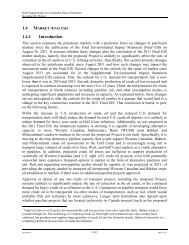tuw5P
tuw5P
tuw5P
You also want an ePaper? Increase the reach of your titles
YUMPU automatically turns print PDFs into web optimized ePapers that Google loves.
forecasts of US oil production were showing a decline. All this changed with the “fracking”revolution (meaning a combination of hydraulic fracturing, horizontal drilling and seismic imagingtechnology), which quickly opened up vast resources of “tight” oil to exploitation—primarily inNorth Dakota (the Bakken play) and Texas (the Eagle Ford play and the Permian play)—andreduced US oil imports to new lows.Combined with limited pipeline and rail transport capacity, this increase in oil production in theUnited States (see Chart 1) has led to bottlenecked oil supplies in the Midwest and a reduction incrude prices there. The situation has been exacerbated by the inability of most US refineries toefficiently process the light crude coming from these fields (particularly in refinery hubs along theLouisiana and Texas Gulf Coast, although Valero is an exception).Chart 1. Growth in Production of Domestic Tight Oil, 2000–2012Source: EIA 2013c.Stakeholder PositionsThe reaction to this situation has been predictable. Most of the oil and gas industry wants theexport ban lifted. The additional demand for US light crude oil will increase profits, althoughprobably not prices because oil is priced in a world market (more to be said about this below).However, some refiners are benefitting from the bottlenecked supplies because they can processthe discounted light crude and sell refined products—gasoline primarily—that generally haveprices tied to world markets. They oppose lifting the ban.Environmental groups also oppose lifting the ban. They see increased demand for fossil fuels ascontributing to greenhouse gas emissions worldwide and are concerned about other2 B R O W N E T A L . | R E S O U R C E S F O R T H E F U T U R E



